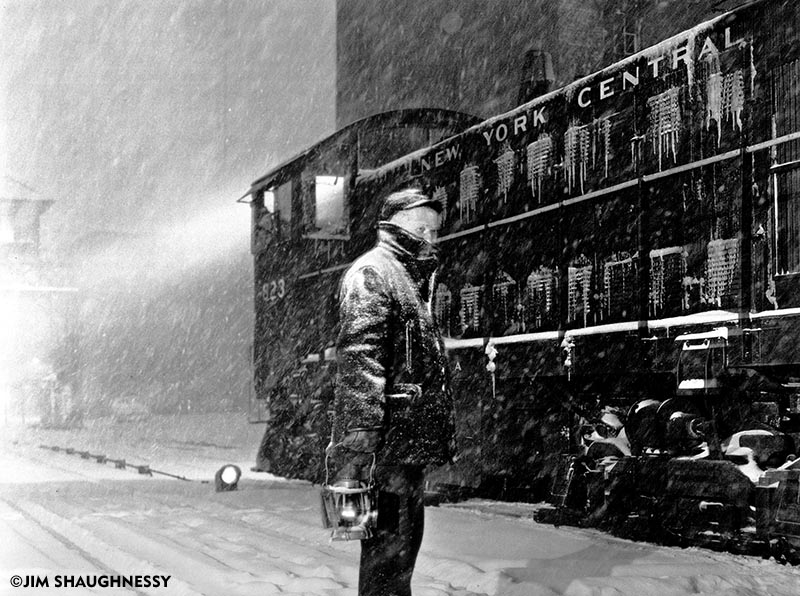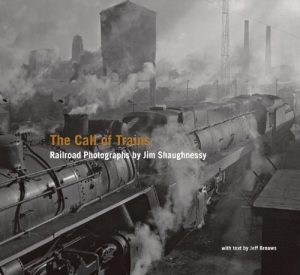 Review by Otto M. Vondrak/photos as noted
Review by Otto M. Vondrak/photos as noted
It took me a while to assemble my thoughts for this review, due to the depth of material presented. I explored the work from many angles, trying my best to understand the photographer and what drives him. The theme of this review will be creativity within the greater context. To that point, I just came back from a Nine Inch Nails concert at the Meadowlands in New Jersey. I have a range of musical tastes, including the “industrial” rock of Nine Inch Nails’ front man Trent Reznor. Some of you may already be turned off, wondering what “that crazy music” has to do with the classic work of Jim Shaughnessy. Going back to our theme of context, I am going to try to offer my impressions of The Call of Trains: Railroad Photography of Jim Shaughnessy based on my own unique experiences as a young photographer.
Trent Reznor is an interesting personality in the music world. Growing up in a relatively sheltered western Pennsylvania, he sought to break out and see what the world had to offer. A classically trained musician, one of his strengths was the piano (which explains some of the passages you hear in his music today). He later found work in a recording studio, and asked if he could use the studio during off-hours to record his own demos. Not looking to take over the music world by storm, Reznor was simply looking for an outlet of expression. “I’ve got all these messages in my mind, and writing these songs is my way of getting them out,” he explained to the audience last night, “and the idea that so many of you out there are able to relate and connect with them is really encouraging.” And the messages are truly his, as he writes and performs all the parts in studio (only employing a session drummer). When he goes on tour, only then does he select musicians to perform with him. Hardly selfish or egotistical, Reznor doesn’t feel comfortable making other musicians express his emotions. How does this connect to a railroad photographer with a career going on fifty years? No one told Jim Shaughnessy to go out and take great photos. He wasn’t influenced by his contemporaries. He simply followed his passions. Shaughnessy presents his work without pretense or ego, but don’t let his straightforward manner belie the true creativity of his work.
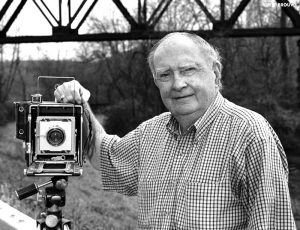 You might say it is Shaughnessy’s unpretentious quality that draws us near. The team of Beebe and Clegg popularized the railroad photo book at mid-century, filling pages with representative photography and lush, emotional text. Can we blame the poet-gourmand-railfan for embellishing his words and offering up a bit of showmanship? It was in this era that Shaughnessy was making his first images, though far removed from the gilt edge of romanticized “high iron” writing. Though it was Beebe himself who said, “If anything is worth doing it is worth doing in style, and on your own terms, and nobody goddamned else’s!” In an interview I recently conducted, Shaughnessy himself makes no pretense about his photographic ability: “A style develops unconsciously,” he said. Already thinking ahead to presentation, Shaughnessy said, “I often think when I take a picture, how will this look as a print on the viewing table?”
You might say it is Shaughnessy’s unpretentious quality that draws us near. The team of Beebe and Clegg popularized the railroad photo book at mid-century, filling pages with representative photography and lush, emotional text. Can we blame the poet-gourmand-railfan for embellishing his words and offering up a bit of showmanship? It was in this era that Shaughnessy was making his first images, though far removed from the gilt edge of romanticized “high iron” writing. Though it was Beebe himself who said, “If anything is worth doing it is worth doing in style, and on your own terms, and nobody goddamned else’s!” In an interview I recently conducted, Shaughnessy himself makes no pretense about his photographic ability: “A style develops unconsciously,” he said. Already thinking ahead to presentation, Shaughnessy said, “I often think when I take a picture, how will this look as a print on the viewing table?”
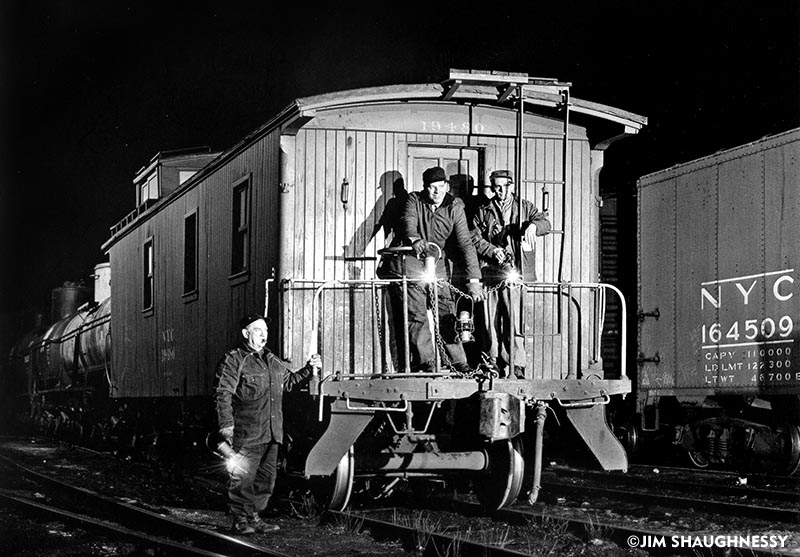
The evening switching crew at New York Central’s West Albany freight yard prepare to go on duty, February 22, 1961. Photo by Jim Shaughnessy
Shaughnessy also took note of the many ongoing discussions regarding railroad photography style, and the motive of the photographer. He commented how many artists try to be different “for the sake of being different.” He explained how this was never what he was trying to do. “Just being different is not enough,” he says. “I’ve been told that this book represents a more artistic side of my photography,” in part due to the selections made by editor Jeff Brouws. Perhaps because we know his work as individual pieces, it makes it difficult to define his work. But in an era that demands labels, Shaughnessy says “I guess I’m an ‘environmental’ photographer now,” pausing to laugh. “There is no concrete conclusion,” when it comes to style. Says Brouws, “I think one of the reasons we are so drawn to Shaughnessy’s work is the fact that he exhibited such a maturity of style at an early age.” Examine his early snapshots around Troy Union Station with his later refined work, and you’ll find many of the same inherent qualities.
With such a substantial work, where do you start? The Call of Trains contains so many layers of rich information, it’s very hard to simply sit still and start on page one. Each photo beckons you to turn the page, to see what lies in wait. Jeff Brouw’s excellent introductory essays cover many areas, giving the reader not only a better understanding of Jim Shaughnessy’s work, but also his influences and frame of reference that really put this collection into context. You get the impression you are walking though a gallery as we discuss Shaughnessy’s life, his passions, examine his possible influences and draw conclusions about his success. The essays are supportive, and do not to over-analyze his work. We begin with an overview of the environment of upstate New York and New England, and Shaughnessy’s childhood in Troy, N.Y. Shaughnessy enjoyed “joy rides” into the New England countryside with his parents, who were all too happy to share young Jim’s railroad hobby (and get out of the house at the same time). Could it be that a young photographer was influenced by the encompassing landscapes of his hero, Ansel Adams?
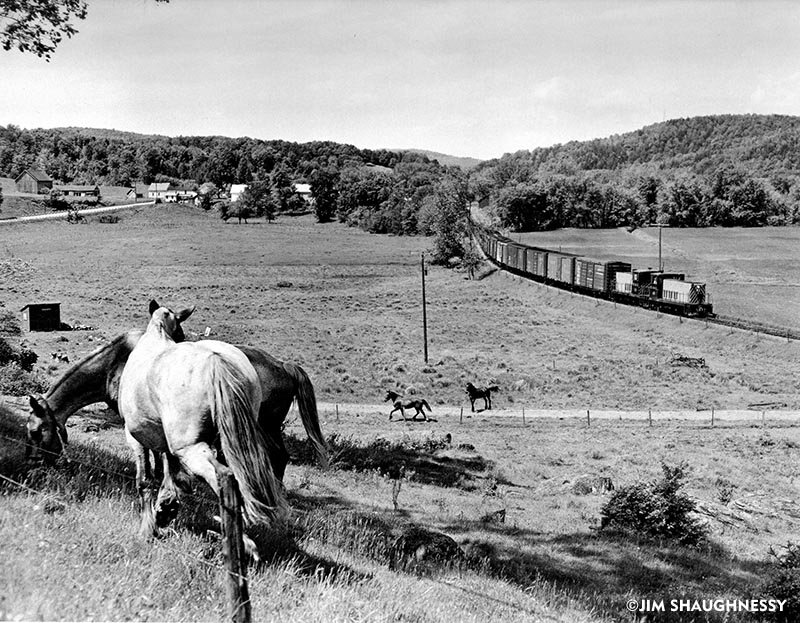
In one of the photographer’s favorite images, the St. Johnsbury & Lamoille County mixed train No. 44 rolls east through Lamoille County in Vermont, while horses enjoy the pasture and attempt to chase the train in September 1955. Photo by Jim Shaughnessy
We follow through the college years, and the excursions farther afield with new friends. We follow along, driven by the same passion (and self-admitted “obsession”) as we bump from one railroad town to the next. Brouws then discusses various concentrations of Shaughnessy’s work, from “staged” photos in the yards to dramatic coordinated night shoots. The extent of “viewer participation” is also explored, as well as his attention to the “human aspect” of railroading. Finally, we explore how Shaughnessy’s “environmental” photography manages to capture so much more than a train rushing through a scene, they capture a sense of place that has often been lost to the ages. While Shaughnessy is rightfully an accomplished photographer, what impresses me the most is his drive to contribute and share–even today. It is not uncommon to find his byline in the latest issue of the northeastern monthly Railpace, or other publications. How humbling that Shaughnessy is still out there today, capturing the latest “news” and rushing to send it in to the editors, hoping for the same acceptance we all desire for our own work!
I made reference earlier to Trent Reznor, and his design and execution of nearly every aspect of his live shows and studio albums. The resulting product is a tight, clear rendition of the artist’s vision. I draw the same conclusions to Jim Shaughnessy. “You can create a particular situation on canvas and create emotion,” he told me, “In photography, you can do that up to a point… but you have to wait for all the elements to come together and capture the moment.” Brouws calls Shaughnessy the “art director in the yards,” unabashedly posing workers and equipment to capture the moment in his mind’s eye. The results are not unlike a fine still life painting, not stiff and posed, but full of rich textures and emotion.
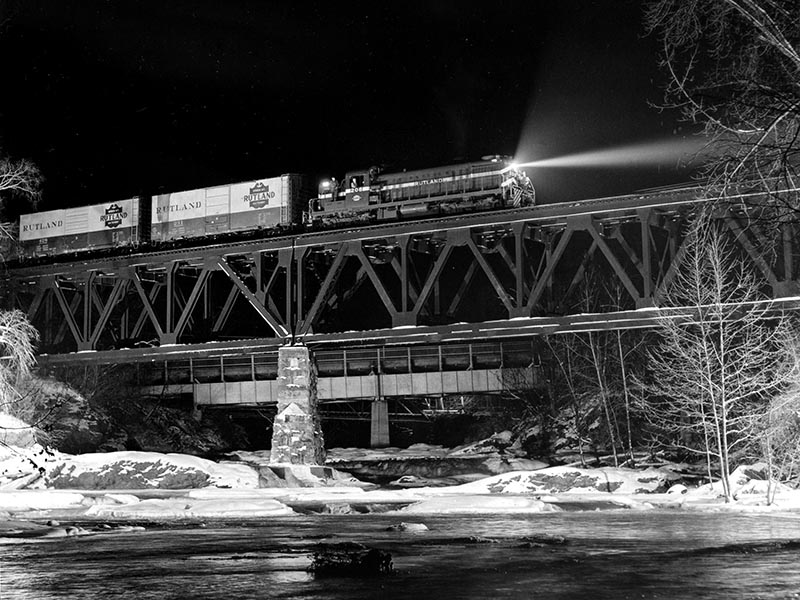
Rutland Railway freight train RC-2 from Rutland, Vt., to Chatham, N.Y., crosses the high bridge over the Walloomsac River at North Hoosick, N.Y., in 1959. The train was posed briefly on the bridge to allow the photographer and his helpers to light the scene with flashbulbs. Photo by Jim Shaughnessy
The genesis for this book lies in earlier projects by Jeff Brouws, the first being Starlight on the Rails. In 1982, he first contacted Shaughnessy regarding the use of some of his many night shots. As production continued on that project, Shaughnessy would check in from time to time and thus began a rich professional collaboration. The release of Starlight on the Rails was followed up by a collection of Richard Steinheimer’s work, A Passion for Trains. It was around this time when Brouws encouraged his friend Shaughnessy to consider a collection of his own, and the process began. To the gasping surprise of archivists everywhere, Shaughnessy’s collection of 60,000 images is simply stored in shoe boxes. How do you whittle down a lifetime of work to a single collection? “I have a lot of pictures [in my collection],” Shaughnessy said, “and I like them all!” Brouws would take home three or four shoe boxes at a time to cull images and start an editing pile. Soon the pile was whittled down to 600, then 300, then to about 180 over the course of 14 months. Coupled with six months of interviews, it was a daunting process that yielded spectacular results.
You will come back to this book over and over as there is just simply too much to absorb in one sitting. I literally had to put down the book and walk away in order to process the fantastic imagery and essays. Think Shaughnessy only ventured as far west as Starucca Viaduct? The very first photo in the gallery section is of two workers examining a Rio Grande narrow gauge “Mudhen” in Alamosa, Color., in 1959. Yes, the familiar locations are depicted in this book—Troy, Cohoes, Starucca, Colonie, West Albany—not to mention the familiar favorite roads—Delaware & Hudson, New York Central, Rutland, Boston & Maine—but it doesn’t end there. Shaughnessy’s passion drew him north to Quebec for Canadian steam, and south of the border for workaday Mexican 2-8-0’s. He visited the deep South, capturing the last days of Norfolk & Western steam and working carefully not to compete with Link’s project. He was in the Midwest, capturing the Q’s 4-8-4’s in twilight. Yes, Shaughnessy obeyed the call and ventured West to chase Union Pacific’s Big Boy in Wyoming. The end of steam operations did not dampen Shaughnessy’s enthusiasm. I think it is important to note that his 1970’s era photos of Erie Lackawanna SD-45’s have the same strength and personality as his earlier dramatic images of fire-breathing Hudsons and Northerns. The triumphant arrival of PA’s (and big GE’s) on his beloved D&H were favorite subjects, too. I think many will be surprised to realize that Shaughnessy is also a prolific night photographer. Dramatic compositions of trains, people, and stations against an inky night delight and absorb the reader.
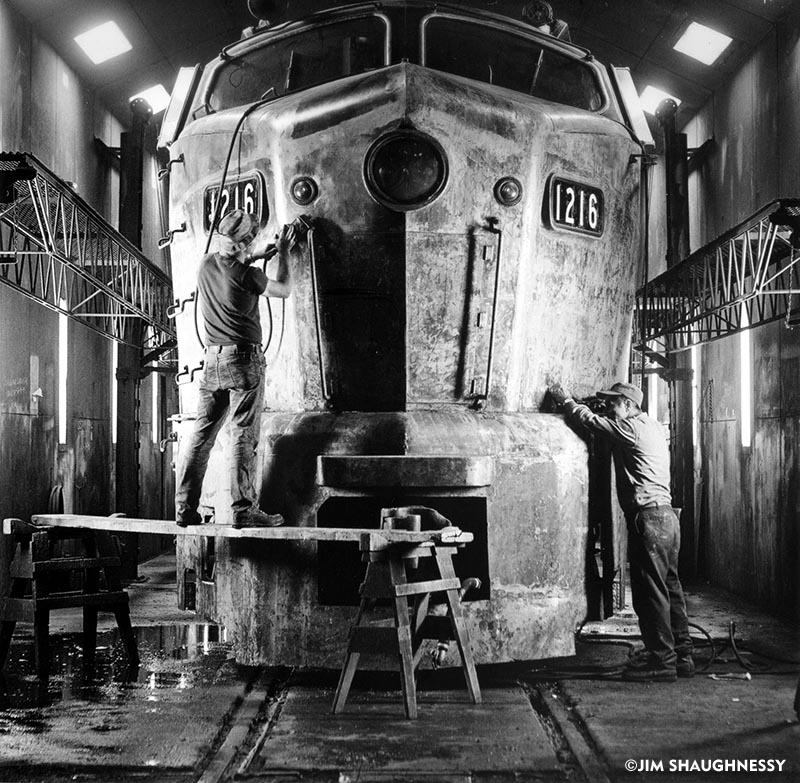
Delaware & Hudson Baldwin RF-16 1216 inside the paint shop at Colonie, N.Y., September 10, 1974. Photo by Jim Shaughnessy
A few of my favorite shots include workers at D&H’s Colonie Shops prepping a Baldwin RF-16 for new paint and a new lease on life. The symmetry and balance of the sharknose offset by the two workers (one on the floor, another balancing on workhorses) is just perfect. Another favorite is the crossing guard in Troy, N.Y., braving a driving snowstorm, with his nose buried into his upturned collar. An NYC Alco switcher overshadows him, the engineer leaning out for a better view. The storm is so heavy, you can barely see the tower in the background. What a night! And yet, there was Shaughnessy, out in that storm, capturing his vision. Another favorite shot is taken from inside the car, as a B&O steam engine pulls a cut of cars across a bridge. Every image in this book presents the same kind of “you are there” involvement. We are not passive viewers of Shaughnessy’s work, we become active participants inserted into each scene. Another parallel to Nine Inch Nails is in their live concerts. Every show is a combination of light and image and sound, creating a fabric of experience. There are few pauses in a NIN show, and they deliver a steady stream of hit songs that barely give you a chance to catch your breath. The Call of Trains likewise delivers hit after hit on every page.
This book is simply beautiful. From a production standpoint, this is probably one of the tightest publications I’ve had the pleasure of viewing. Printed in Italy, the attention to detail is evident, from Brouws thoughtful design through to the cloth binding of the pages. It is simply designed, which means fewer distractions that allow you to enjoy the photographs. The reproduction of each photo is sharp and crisp and as near perfect as you can get. The rich tonal values are a result of a process that layers three levels of ink. First, black ink is applied for the majority of the tonal values, then a warm gray ink is applied to enrich the midtones, then a third hit with black to bring out the contrast and shadows. The result is a striking image engaging the reader on every page. Brouw’s smart design allows each photo to stand on its own merits, freeing each image to be absorbed by the reader. Each photo is reproduced as large as possible, with minimal title info provided alongside. The back of the book contains thumbnails of each photo paired with more detailed caption information. The thoughtful essays from Brouws are accessible to any reader, and colorful reminiscences from Shaughnessy complete the volume.
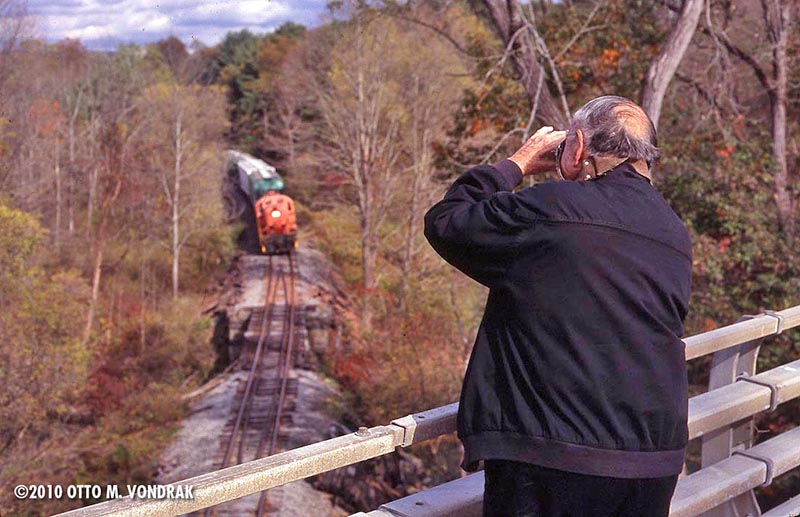
Jim Shaughnessy photographs the Alco-powered Batten Kill Railroad from the Route 67 overpass in Eagle Bridge, N.Y, on October 19, 2010. Photo by Otto M. Vondrak
Oh, and back to my point about context and creativity, you don’t need to be from the “Elvis Generation” to appreciate good photography. What’s more, you can have an appreciation for remixed industrial rock and still share a passion with someone who does not. The link from one generation to the next is not broken. Do not shy away from this book just because you think, “Jim’s only an Eastern photographer,” or “Shaughnessy only took steam engine pictures,” or “Most of his shots were staged.” Contained in this book are clear, sharp photos that capture a moment in time with the observer as the central subject. You will return to this book again and again, never seeing the same thing twice. It is a spectacular album and an overdue tribute to a photographer that has not sought the limelight, yet deserves it all the same.
—Originally published September 14, 2008, courtesy Railroad.net



